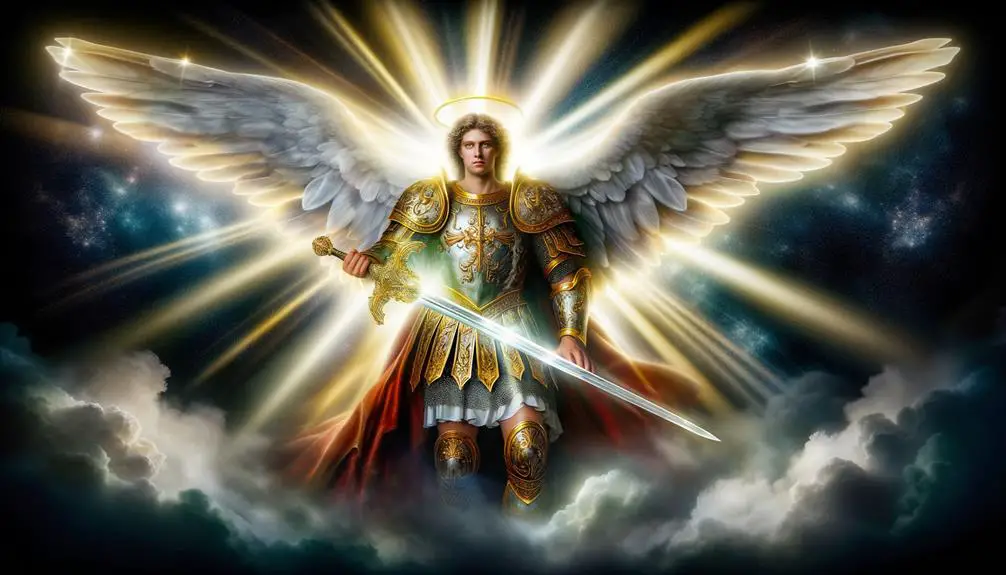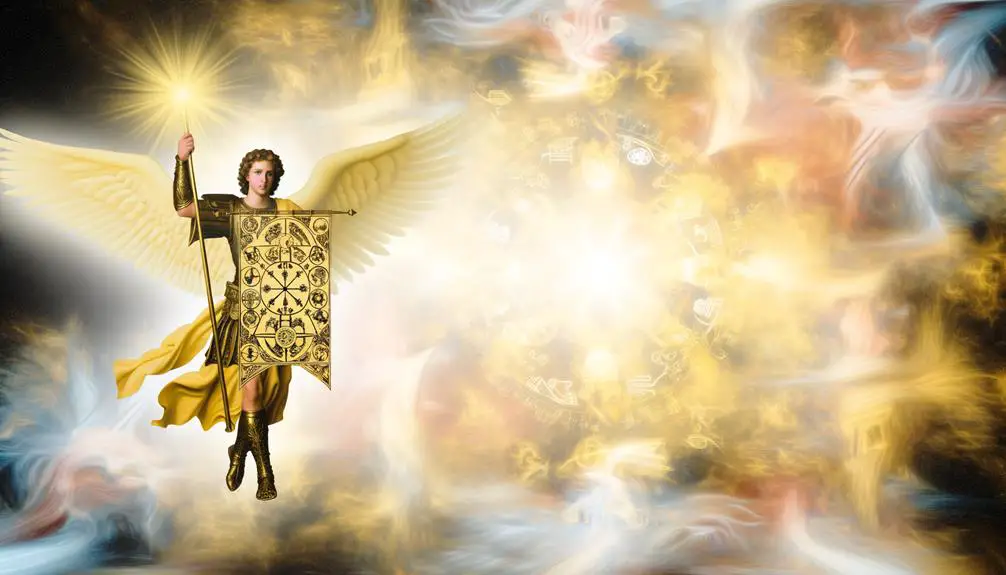What Symbolizes St. Michael the Archangel?
St. Michael the Archangel is symbolized through various elements, each reflecting his divine roles and attributes.
The sword signifies his role as a celestial warrior and arbiter of justice. The scales represent his function in the divine judgment of souls.
The shield symbolizes his defensive protection against evil. The dragon embodies chaos and his triumph over darkness.
The banner highlights his identity as a heavenly warrior, reflecting chivalric values. Additionally, the halo underscores his sanctity and divine authority.
These symbols collectively articulate his theological importance and enduring presence in spiritual warfare and moral justice. To explore further, myriad historical and theological nuances await discovery.
Key Takeaways
- The sword symbolizes St. Michael's divine justice and role as a celestial warrior.
- The scales represent his function as the arbiter of souls and divine judgment.
- The shield signifies defense against evil and St. Michael's protective role.
- The dragon embodies chaos and evil, highlighting St. Michael's triumph over demonic forces.
- The halo denotes his divine holiness, celestial authority, and role as a guardian of righteousness.
The Sword

St. Michael the Archangel's sword is a potent symbol of divine justice and protection, deeply rooted in religious and historical contexts.
In Christian iconography, the sword represents St. Michael's role as a celestial warrior, tasked with upholding God's divine law and combating evil forces. This imagery is profoundly influenced by biblical accounts such as Revelation 12:7-9, where Michael leads the heavenly army against Satan.
Historically, the sword has also been emblematic of chivalric values, associated with the defense of righteousness and the vanquishment of malevolent entities. Its depiction in various art forms, from medieval manuscripts to Baroque paintings, underscores its enduring significance as a powerful instrument of divine will and moral rectitude, elevating St. Michael's stature in religious tradition.
The Scales
The scales held by St. Michael the Archangel are potent symbols of balance and justice, reflecting his role as the divine arbiter of souls.
Historically, these scales have been depicted as instruments used to weigh the moral worth of souls, thereby determining their eternal fate.
This imagery underscores the theological concept of divine judgment, positioning St. Michael as a guardian of moral equilibrium.
Balance and Justice
In the iconography of St Michael the Archangel, the scales symbolize his divine role in administering balance and justice. This imagery aligns with theological interpretations of Michael as a celestial arbiter who secures moral equilibrium. The scales serve as a potent emblem, encapsulating key aspects of his duties:
- Judicial Fairness: The scales represent impartiality, underscoring Michael's role in executing divine justice without bias.
- Moral Integrity: They signify the measure of virtue and vice, reinforcing the principles of ethical conduct.
- Equitable Judgement: The balanced scales illustrate the importance of fair treatment, mirroring the divine law that governs human actions.
Thus, St Michael's scales are not merely symbolic but integral to understanding his canonical function within the celestial hierarchy.
Weighing Souls Symbolism
Building upon the depiction of balance and justice, the scales held by St Michael the Archangel also carry profound implications for the weighing of souls, a motif that underscores his pivotal role in the eschatological narrative. This symbolism is deeply rooted in theological traditions where St Michael acts as a psychopomp, guiding souls to their eternal fate. The scales reflect divine judgment, where each soul's deeds are measured to determine their righteousness or sinfulness.
| Aspect | Symbolism | Theological Importance |
|---|---|---|
| Scales | Balance and Judgment | Divine fairness |
| Weighing Souls | Moral Evaluation | Eschatological significance |
| St Michael as Psychopomp | Guide of Souls | Ultimate arbiter |
| Divine Judgment | Righteousness vs. Sinfulness | Eternal destiny |
| Eschatological Role | End-Time Decisions | Key to afterlife outcomes |
This table elucidates the multifaceted dimensions of St Michael's scales, enhancing comprehension of their spiritual significance.
Shield of Protection

Representing a formidable defense against evil, the shield of protection is a significant emblem associated with St Michael the Archangel. This symbol epitomizes his role as a divine guardian and protector against malevolent forces. The shield is not merely a piece of armor but a profound metaphor for spiritual fortitude and divine safeguarding.
Key aspects include:
- Spiritual Defense: Illustrates St Michael's role in defending the faithful from spiritual harm.
- Symbol of Faith: Embodies the strength and support provided by unwavering faith.
- Historical Legacy: Reflects the rich iconography and historical depictions in religious art and literature.
This emblem serves as a visual and symbolic reminder of St Michael's protective presence and the spiritual warfare against evil.
The Dragon
The dragon, often depicted as a formidable beast, serves as a powerful symbol of chaos and evil in the iconography of St Michael the Archangel. This representation draws from the Book of Revelation, where St Michael leads the heavenly host in a decisive battle against the dragon, identified as Satan.
The dragon's ferocity and malevolence contrast sharply with St Michael's virtues of bravery, righteousness, and divine authority. By vanquishing the dragon, St Michael embodies the triumph of good over evil. This imagery not only reinforces the archangel's role as a protector against demonic forces but also serves as a theological assertion of divine order prevailing over chaos.
Consequently, the dragon is integral to understanding St Michael's symbolic and doctrinal significance.
The Banner

The banner held by St. Michael the Archangel is a profound symbol whose color and design are imbued with significant meaning.
Historically, this banner has been utilized in various religious and artistic contexts to convey themes of divine victory and protection.
Symbolically, the banner represents St. Michael's role as a heavenly warrior, championing the forces of good against evil.
Color and Design Significance
Frequently central to the iconography of St Michael the Archangel, the colors and design of his banner hold profound symbolic meaning in Christian tradition. The banner is often depicted in hues that carry significant theological implications. The predominant colors are:
- Red: Symbolizes martyrdom, sacrifice, and the divine justice St Michael administers.
- Gold: Represents divinity, eternal glory, and the triumph of good over evil.
- White: Signifies purity, righteousness, and the angelic nature of St Michael.
The design elements, such as crosses and swords, further emphasize his role as a divine warrior and protector against evil. These symbolic choices are not arbitrary; they are deeply rooted in biblical narratives and ecclesiastical art, underscoring St Michael's celestial authority and moral fortitude.
Historical Context and Usage
Historical records indicate that banners bearing the image of St Michael the Archangel have been utilized across various epochs and cultures, serving as potent symbols of divine protection and martial valor.
During the medieval period, these banners were often carried into battle by Christian knights, reflecting their reliance on St Michael's intercessory power.
In Byzantine iconography, the archangel's image on banners signified imperial authority and celestial guardianship.
In the context of the Reconquista, Spanish forces employed such banners to signify their struggle against Moorish occupation.
The usage of St Michael's image on banners transcended mere decoration, representing a theological and sociopolitical assertion of divine endorsement and moral righteousness in both military and civic spheres.
This way, these banners encapsulated multifaceted historical significance.
Symbolic Representations and Meanings
Banners bearing the image of St Michael the Archangel encapsulate a complex interplay of symbolic representations, blending notions of divine protection, martial valor, and moral authority. These banners serve as a visual reflection to St Michael's role as the protector against evil and the leader of the heavenly armies. The imagery often found on these banners reinforces key theological and moral principles:
- Divine Protection: St Michael's presence signifies safeguarding against spiritual and physical dangers.
- Martial Valor: His depiction as a warrior emphasizes courage and the righteous fight against malevolent forces.
- Moral Authority: The archangel's role as a judge underscores the importance of justice and ethical integrity.
This symbolic richness makes banners of St Michael potent emblems within both religious and cultural contexts.
The Halo
The halo, often depicted as a radiant circle or disc surrounding the head of St. Michael the Archangel, serves as a potent symbol of his divine holiness and celestial authority.
In religious iconography, the halo signifies sanctity and the presence of divine light, marking St. Michael as a heavenly being and an emissary of God. This visual element underscores his role not only as a warrior against evil but also as a guardian of righteousness.
The use of the halo can be traced back to early Christian art, where it was employed to differentiate holy figures from mortals. By contextualizing the halo within theological and artistic traditions, one appreciates its profound role in conveying St. Michael's sacred and exalted status.
Conclusion
In sum, the symbols associated with St. Michael the Archangel—such as the sword, scales, shield of protection, dragon, banner, and halo—each encapsulate distinct aspects of his divine role and attributes.
The sword signifies justice, the scales denote balance, the shield represents protection, the dragon embodies vanquished evil, the banner conveys leadership, and the halo signifies sanctity.
Together, these symbols coalesce into a vivid tapestry, illustrating the multifaceted nature of this celestial warrior within theological and iconographic contexts.






